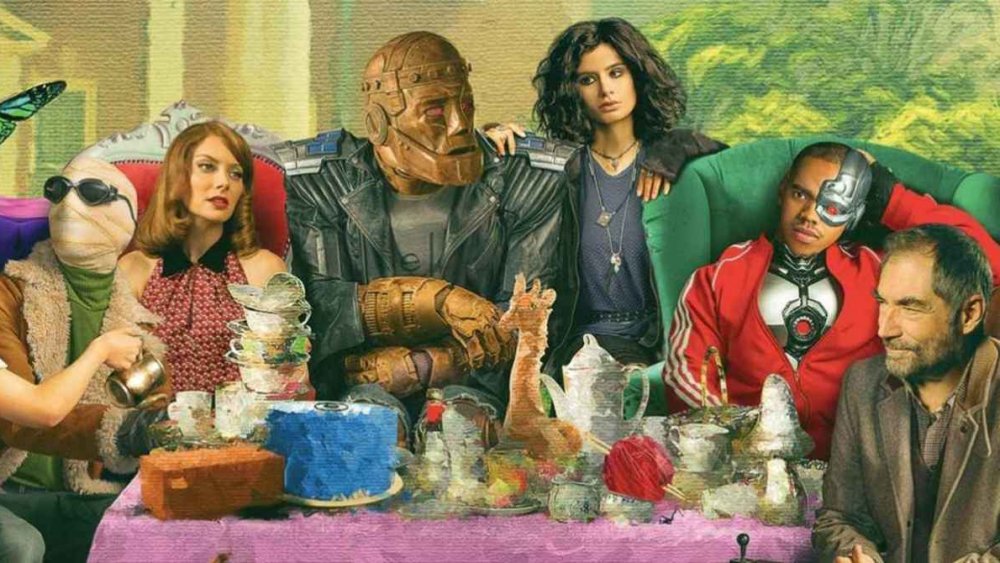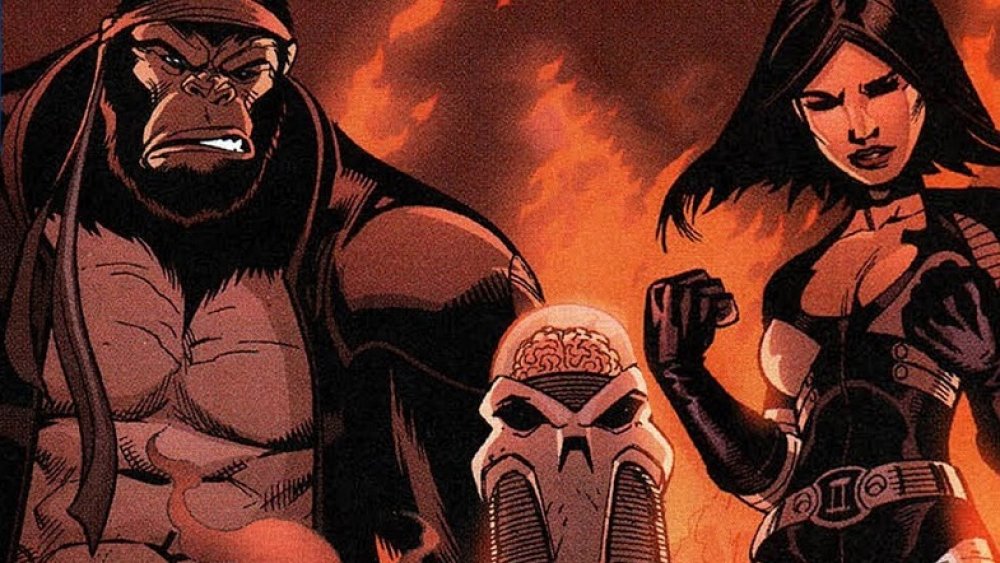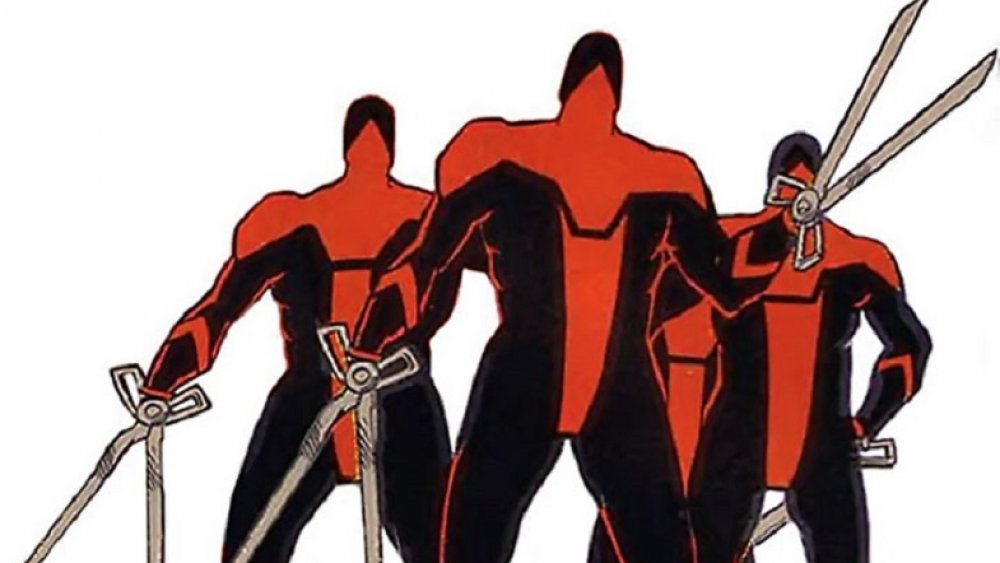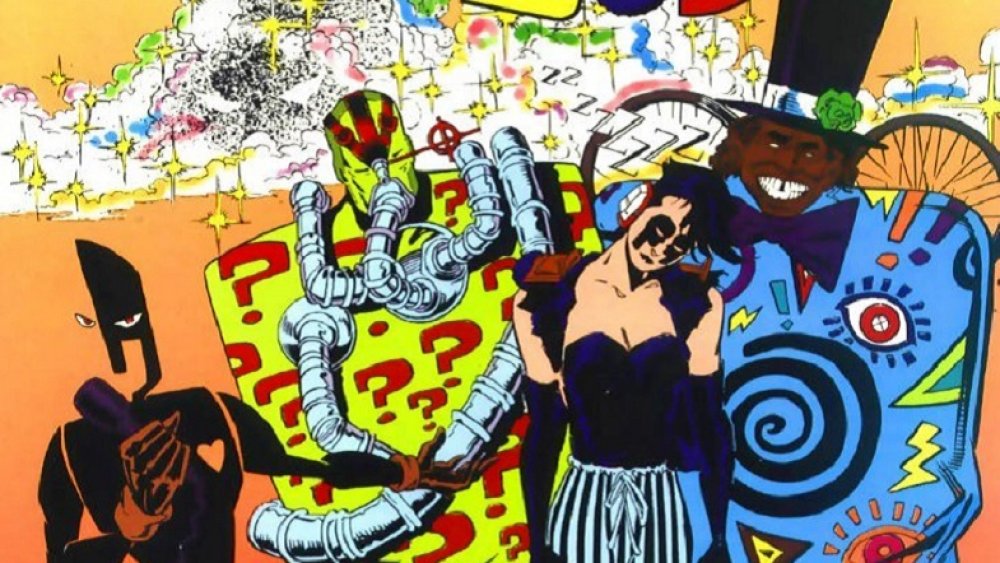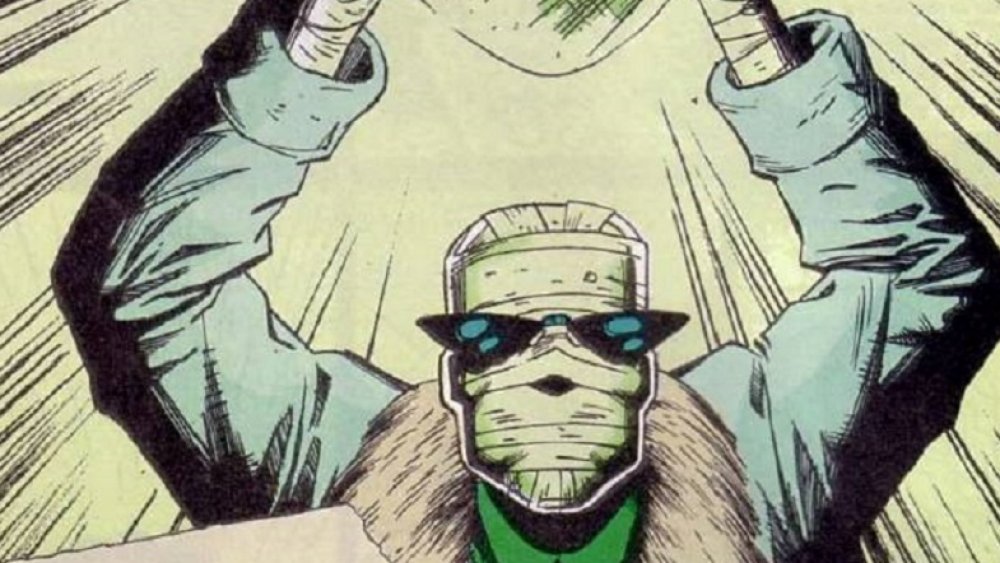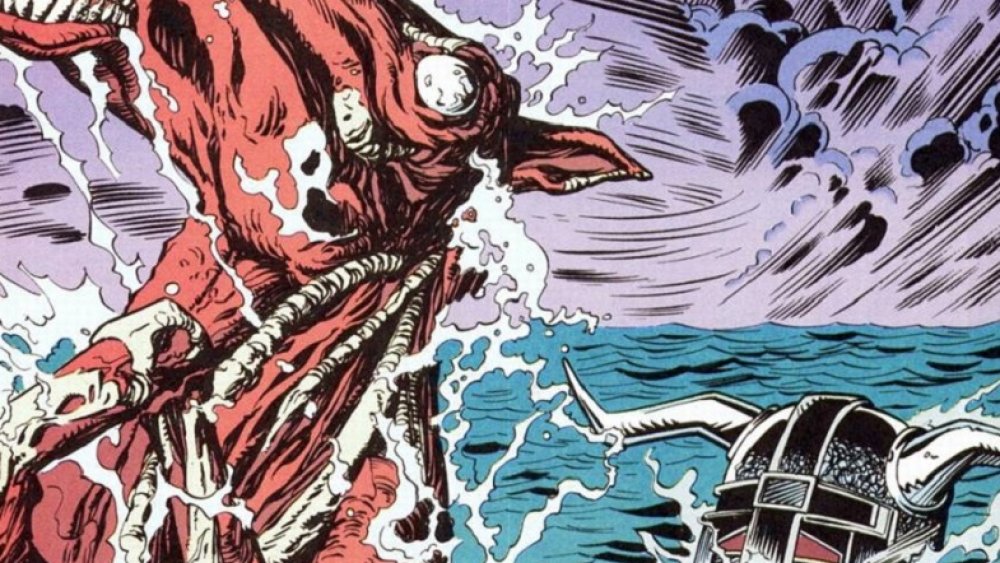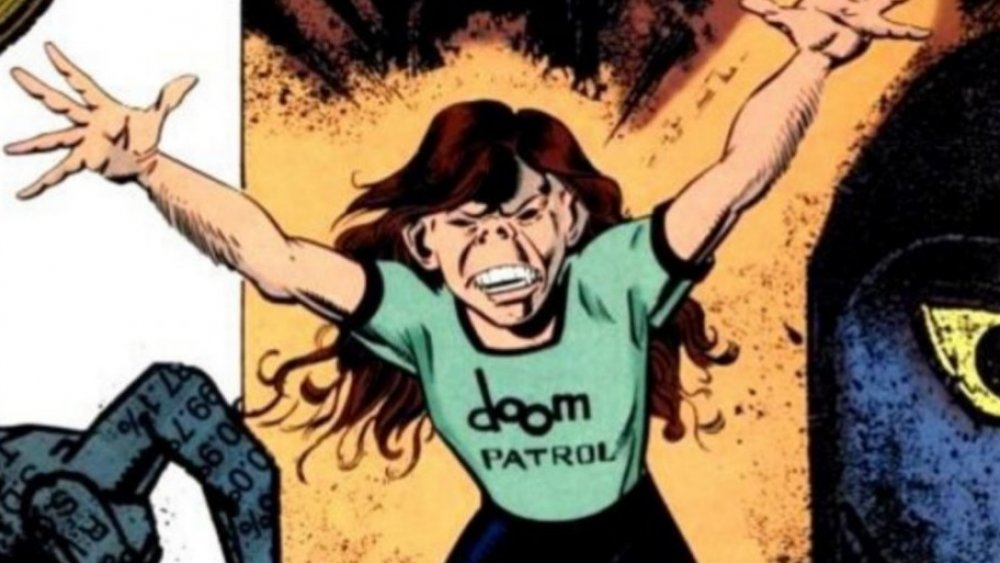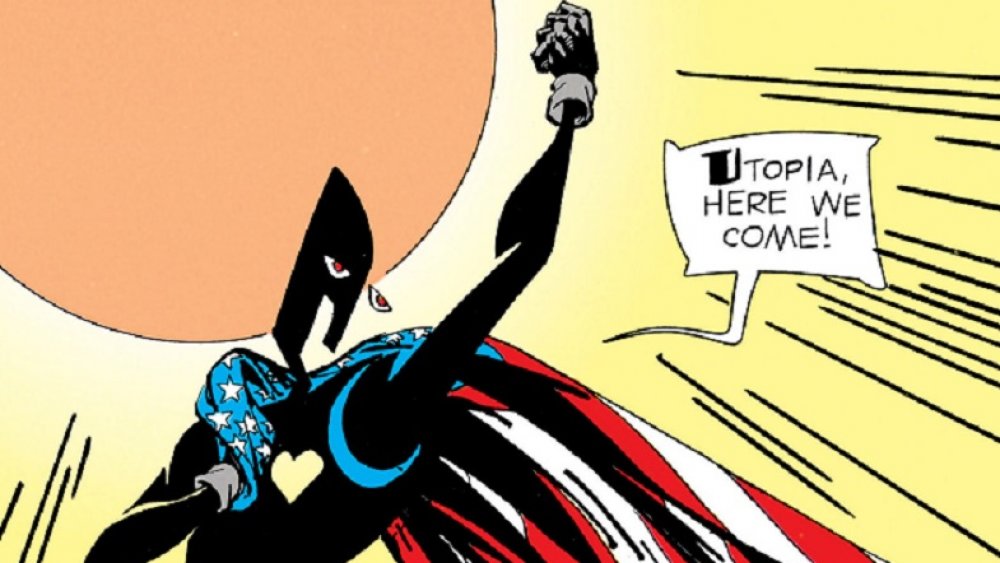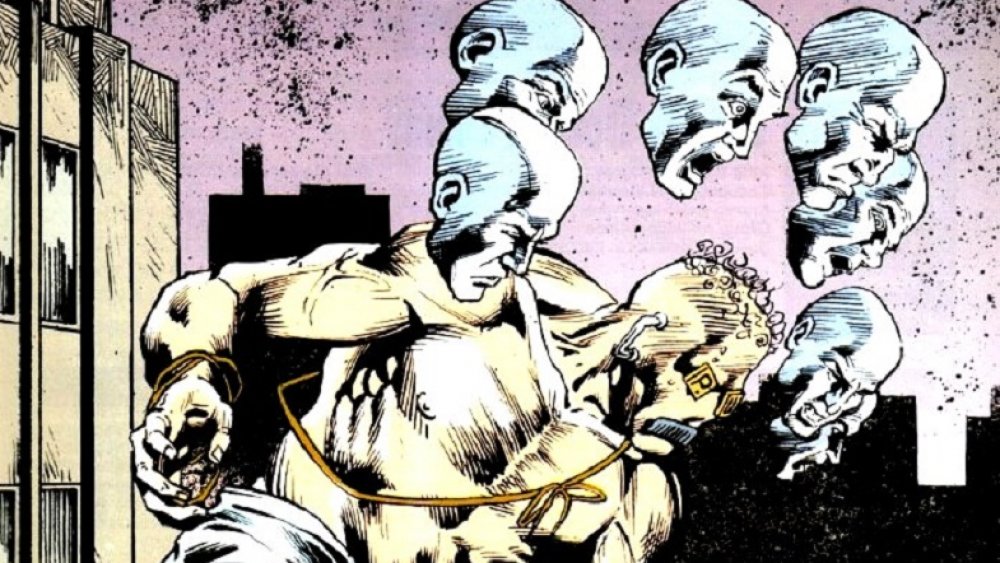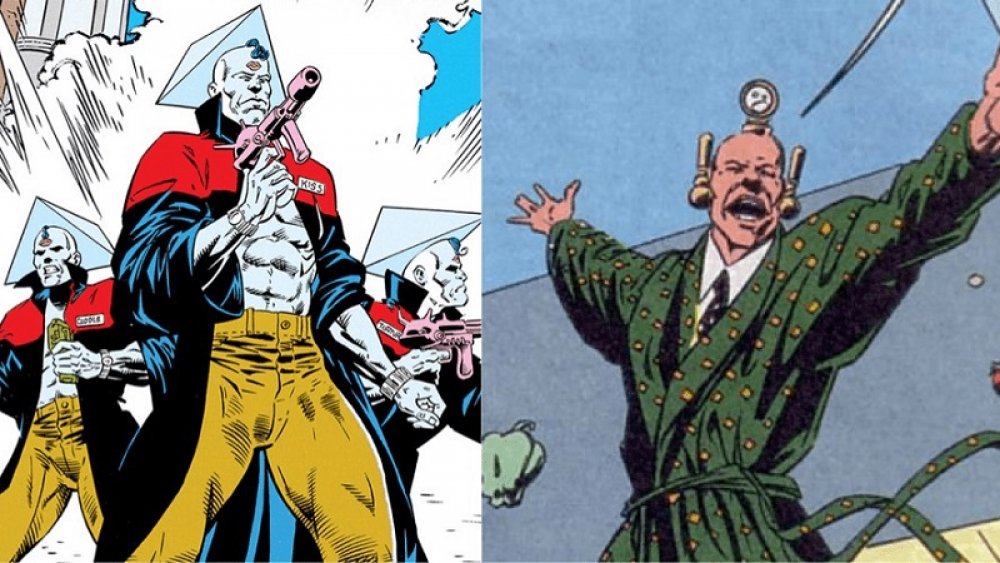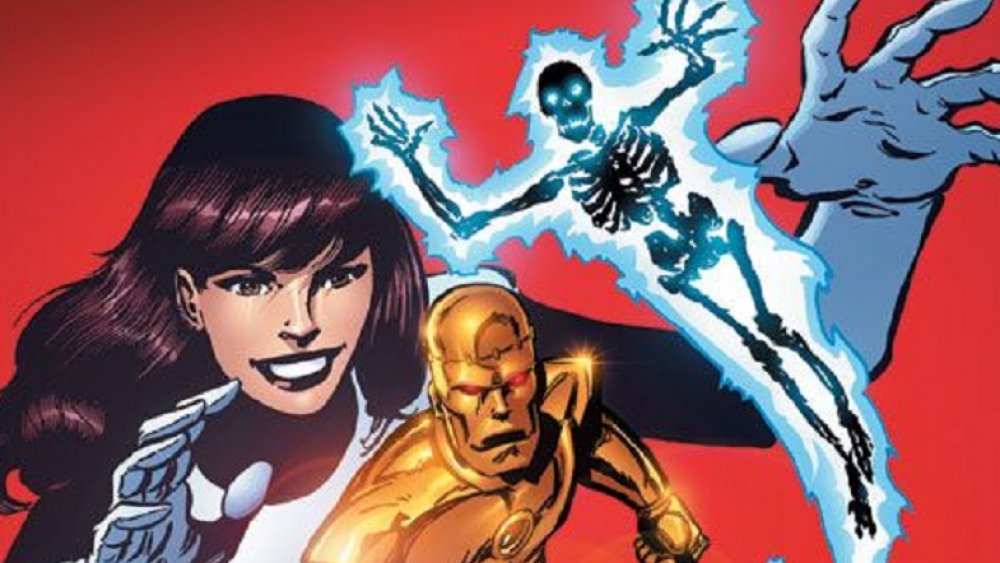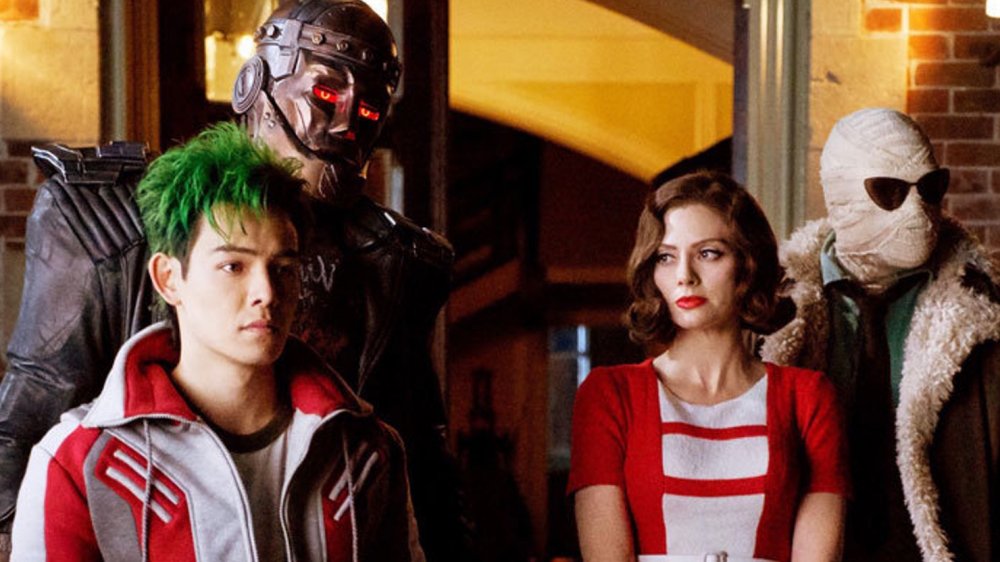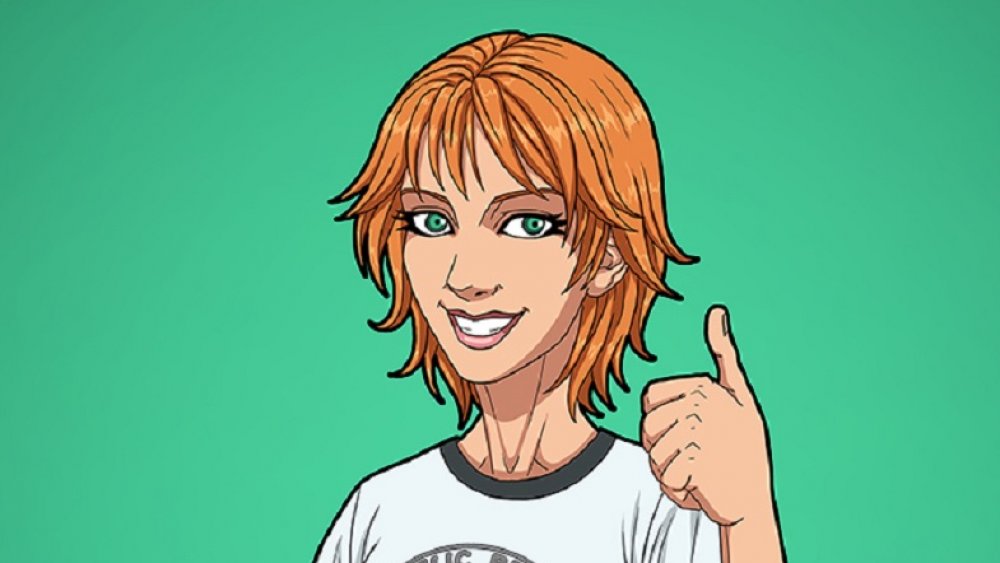Things Fans Want To See In Doom Patrol
For longtime fans of the Doom Patrol comic, the first season of the television show surpassed all expectations of weirdness. The show built its foundation on the comic book series created by Arnold Drake, Bob Haney, and Bruno Premiani, which debuted in June of 1963 and followed the adventures of the titular group of outcasts who band together to protect a society that shuns them.
The original Doom Patrol consisted of Cliff "Robotman" Steele, a race car driver who was reduced to just his brain; Larry "Negative Man" Trainor, a test pilot whose body was inhabited by a mysterious energy spirit; and Rita "Elasti-Girl" Farr, an actress whose skin became rubbery. They were led by the Chief, Niles Caulder, a wheelchair-bound scientist. The team died in the final issue of their title.
In the early 1990s, the Doom Patrol was subject to a massive rethinking by writer Grant Morrison, who turned the series into an absurd but frequently poignant deconstruction of superheroes that focused on the horrific power of fairy tale images and cold, distant authority figures. Much of the TV show is based on his ideas, starting with the villain and narrator of the series, Mr. Nobody.
From Crazy Jane, each of whose 64 personalities has a different superpower, to Danny, a sentient, teleporting, gender-queer street, and Flex Mentallo, the master of muscle mystery, it's been astounding to see Morrison's vision brought to life. Now that a second season of the show is here, what else can fans expect?
Brotherhood of Evil
Mr. Nobody refers to his old teammates in the Brotherhood of Evil on the show, and when you mention a brain in a jar and a gorilla who speaks French in season one, you simply have to introduce them in season two. While the Brotherhood has had a variety of members, the classic lineup consists of the Brain, his creation Monsieur Mallah, and Madame Rouge.
The Brain was a French scientist who experimented on a gorilla and gave it a high IQ. The gorilla, dubbed "Monsieur Mallah," wore a snappy red beret in the style of Che Guevera. When the scientist was dying, Mallah removed his brain and placed it in a high-tech vat. Madame Rouge, meanwhile, was an actress with a split personality; the Brain experimented on her to make her evil side dominant while giving her shapeshifting and size-changing abilities.
The Brain was always jealous of Niles Caulder, and often schemed against him. Interestingly, the Chief and Madame Rouge had a strange attraction for each other. This was too bad, as Madame Rouge was one of the people behind the first death of the team.
During Grant Morrison's run, Mallah and the Brain schemed to transplant his brain into Cliff Steele's new, high-tech robot body. Upon waking up in Cliff's body, they declared their love for each other. Unfortunately for them, the body was booby-trapped.
All of which is to say that the Brotherhood strikes the perfect balance between Silver Age silliness and modern weirdness — and they'd be a perfect addition to Doom Patrol for the show's second season.
Orqwith and the Scissormen
The Scissormen, dressed in red and black, are the relentless assassins of the bone city Orqwith. While they're seemingly no more substantial than a walking paper doll, one of their snips cuts people out of our reality and sends them to Orqwith.
What is Orqwith? It's a city created by a group of philosophers engaging in a thought experiment. They wrote a book called This Book Has No Title, about how the bone city Orqwith pushes through into the real world and destroys it. Somehow, this is exactly what happens, as people start disappearing and the Scissormen show up in greater numbers.
They shout nonsense phrases derived from Grant Morrison's spell checker, which makes them even more terrifying than if they were silent. They represent nonsense authority, the kind of arbitrary force that is so frightening to children. Indeed, they're based on a story from the disturbing German children's book Struwwelpeter.
Rebis beats them thanks to a logical inconsistency built into the city's rulers. There's a priest in black and a priest in white, both with clocks as faces; they represent the classic philosophical riddle of one being a liar and one being truthful, and you have to ask one of them a question. It's the fundamental question of philosophy, which is: "Why is there something instead of nothing?" The liar is forced to state that there is something instead of nothing — and his lie destroys Orqwith. It's a neat trick that would look great onscreen.
Brotherhood of Dada
When Mr. Nobody is transformed into his reality-shifting form in the comics, instead of putting together a new Brotherhood of Evil, he goes in a different direction. He recruits weirdos, outcasts, and freaks in the name of the absurdist anti-art movement Dada — the negation of ideas and rationality through a variety of different techniques, many of which led directly into Surrealism.
The Brotherhood of Dada's first recruit is the Fog, whose real name is Byron Shelley (his parents really liked poetry!). He can turn into a death cloud that absorbs people. The only problem is that their minds stay alive inside of him and won't shut up, leading him to have long arguments with himself. Then comes Lloyd Jefferson, a.k.a. Frenzy. A homeless man from Detroit, he is given a colorful outfit and a spiffy top hat as he transforms into a living cyclone.
Next up is a young woman named Holly McKenzie, whom Mr. Nobody dubs "Sleepwalk." She has super-strength, but only when she's asleep. When the Brotherhood goes on a mission, Mr. Nobody gives her sleeping pills and makes her listen to Barry Manilow on her headphones. Finally, there's the Quiz, a young Japanese woman whose name is never revealed. She's a germaphobe whose power is every power you haven't thought of — but as you list them off, she loses them.
Rebis
During Grant Morrison's run, the Negative Spirit possesses the bodies of its original host, Larry Trainor, as well as a doctor named Eleanor Poole. This alchemical trio dubs hirself Rebis, referring to the end process in alchemy where male and female are balanced in one form. The result is the first intersex superhero, as Rebis is a combination of Poole's, Trainor's, and the Spirit's bodies, memories, and feelings. There's also the balance of race (white and Black). During the run, Rebis pauses to have sex with hirself, creating a new body in the form of a glowing, green egg. There's an issue of the series devoted entirely to this whole process, which takes place on the moon. The balance between male and female made Rebis a revolutionary character at the time — and one that's still quite relevant today.
On the TV show, the relationship between Trainor's own secretive homosexuality and the Spirit is a big part of the character's story. The Spirit's motivations are still mysterious in the series, and deepening the complexity of its enigma by adding in Eleanor Poole to the mix would be fascinating. The Morrison run, at heart, is about the possibility of evolution and growth, and this fits in with the TV show as well.
The Fifth Horseman of the Apocalypse
The Brotherhood of Dada sucks Paris into a magical "hungry painting," but what they don't know is that there is a horrible being lurking inside of it. This entity is Extinction, the Fifth Horseman of the Apocalypse, and its emergence from the painting means the end of everything. The Brotherhood's shenanigans wake it from its long slumber, and it draws power from the symbolic essence of each level of the painting. For example, it gains psychological power from the Surrealist level, and speed from the Futurist level.
Crazy Jane tries to combat its ascent by teleporting inside it, but it's too big for her. Mr. Nobody comes up with the brilliant idea of sending it through the Dada level of the painting. Because Dada is the negation of ideas, the Horseman is stripped of all meaning except its most literal one: it becomes a child's hobby horse. (In French, "dada" means hobby horse.)
Creating the Brotherhood of Dada in season two would also mean an important bit of character development for Mr. Nobody. In the first season, he's consumed by revenge on Niles Caulder and ultimately exposing his hypocrisies. A Mr. Nobody who evolves into a weirder figure, one less obsessed with mere revenge and more interested in self-expression, would be more interesting.
Dorothy Spinner and the Candlemaker
In the last episode of the first season of Doom Patrol, we're introduced to Dorothy, the daughter of Niles Caulder and Slava, an immortal, primitive woman. In the comics, she's introduced as having grown up on a farm, tormented by kids because of her simian features.
The comics version of Dorothy is a teen who's trying to come to grips with her powers, which include the ability to externalize her fears and turn them into real monsters. In one issue, all of this is a metaphor for menstruation, as her childhood imaginary friends come to life and try to force her to wear a pair of red shoes. Once she understands what's going on, Dorothy puts on what are really ruby slippers. There's no place like home.
Later, in an effort to help the Doom Patrol, she asks for help from someone she calls the Candlemaker, who killed one of her childhood tormentors, but she locked him away. He helps her, but warns her that the next she calls on him, he will escape.
Turns out that the Candlemaker is an evil spirit who takes up residence in Dorothy's head. He eventually escapes and possesses a super-powered artificial body Caulder has created, which allows him to do some real damage. Thanks to some nanobots, a newly reconstituted Rebis, and her own resolve, Dorothy blows the terrifying Candlemaker away. It's the ultimate in confronting irrational childhood fears.
Mr. Nobody for President!
After being imprisoned in the magical painting, Mr. Nobody escapes and forms a new Brotherhood of Dada. This time, his plan centers around running for president of the United States after he steals a powerful object: Albert Hofmann's bicycle. Hofmann invented the drug LSD, and riding the bicycle creates psychedelic effects. So Mr. Nobody and his new band of weirdos drive around America in a bus, powered by the bicycle's energy, spreading psychedelic nonsense everywhere.
The new group's first member is Bobby Carmichael, the Love Glove. He dreams of a tree with magic gloves and wakes up armless, but with access to the super-gloves. Then there's Alias the Blur, a nightmarish mirror creature who is the reflection of a vain actress. Agent "!" comes as no surprise; indeed, his super-familiarity is his super-power. Then there's Number None, the invisible, intangible personification of bad luck. The final new recruit, the Toy, only shows up after the fighting ends.
They skirmish with the Doom Patrol, but their battle is inconclusive. Cliff is determined to hunt them down, but Rebis and Jane say "Why bother?" They like Mr. Nobody's campaign! This would be a perfect story for the second season of Doom Patrol, especially around an election year.
Yankee Doodle
Mr. Nobody starts picking up fans and followers as he runs for president, and the government can't let that stand. The Ant Farm is consulted for one of its deadliest agents: John "Yankee Doodle" Dandy. An archeology professor, he stole notes on a spray that can change one's face and became a master of disguise.
The character, created by Lawrence Nadle, is based on a cover of Showcase he was to appear in back in 1964. He remained unused until Doom Patrol #51, when Morrison and artist Richard Case repurposed that old piece of art.
In Morrison's hands, Dandy becomes twisted when he goes on a mission under the Pentagon and comes back disfigured and surrounded by seven floating heads. He's sent after the Brotherhood of Dada and kills all of them before the Doom Patrol can help. Dandy even turns Mr. Nobody human again before Cliff Steele can intervene.
In a comic and a television show filled with bizarre character designs, Yankee Doodle truly stands out. Given Mr. Nobody's ability to break the fourth wall on the show, it would be interesting to see him try to deal with his inevitable end, especially if he becomes a weirder but less threatening figure in the second season.
The Shadowy Mr. Evans and the Sex Men
The Apocalypse is often just another day at the office for the Doom Patrol, and that is certainly true of their encounter with the Shadowy Mr. Evans, who dwells in the Library of Dust, a realm that occasionally intersects with ours — and the result is a portent of the apocalypse. He claims to be the original serpent in the garden, tempting humanity with twisted fantasies. He induces a dream in Cliff Steele of going on a mission with the rest of the Doom Patrol, like normal superheroes.
While he offers temptation, those fantasies are tinged with cruelty and violence. He's pure id in all senses of the word, both violence and sex. All of this is funny because he presents himself as a man of leisure in a bathrobe who just can't be bothered. He's like Mr. Mxyzpltk, if he popped up randomly to cause a different kind of trouble. His presence also helps activate a new personality of Crazy Jane's, the hyper-sexual Scarlet Harlot.
He's immediately opposed by an Ant Farm team dubbed the Sex Men, a group of blue-skinned agents code-named Cuddle, Kiss, and Torture. Armed with anti-orgone guns (sexual energy as described by psychiatrist Wilhelm Reich) and orgone pyramid hats, the Sex Men prove ill equipped to handle the enemy. After Cliff tricks him into leaving our plane, the Scarlet Harlot soaks up the residual sexual energy. Given the show's dip into sexual themes, these characters are a perfect fit.
Rebootmania!
Rachel Pollack took over for Morrison after his Doom Patrol run ended, focusing on Dorothy Spinner, Cliff Steele, and new characters like the trans hero Coagula. Pollack incorporated elements of tarot into the title, but her run lacked the same kind of whimsical absurdity as Morrison's.
The team has subsequently gone through six status quo-demolishing reboots. This would make for an interesting TV episode, as perhaps Mr. Nobody and a competing force could get bored and try to one-up the other with rebooted versions of the team.
In the John Arcudi run, Dorothy has a breakdown and kills most of Pollack's team. The new Doom Patrol consists of Cliff Steele and characters with names like Fast Forward, Kid Fever, and Slick.
John Byrne wiped that out with his version, which rebooted the original team and erased all other continuity. New characters included Nudge and Grunt, and storylines included Cliff and Rita going back in time to their old bodies and falling in love. The only problem? Cliff was an adult and Rita was 12. Needless to say, this version didn't last long.
Keith Giffen's version took place in a reality where all the old Doom Patrols still existed and Bumblebee and Vox became new members, while Gerard Way's run brought back classic members like Crazy Jane. Once the rebooting ended, it would be interesting if a couple of new characters were retained.
Beast Boy
Beast Boy is the one character in the DC Universe TV shows with an already established link to the Doom Patrol, as Garfield Logan was the foster son of Rita Farr and Steve "Mento" Dayton. He sometimes went on missions with the team, but was mostly just a mascot. He joined the Teen Titans after the death of the first Doom Patrol, changing his code name from Beast Boy to Changeling.
His power is simple: he can turn into any kind of animal, although it's always tinged green. His fun-loving, joking persona is a mask for all the pain he's experienced, but there's no question that the Doom Patrol plays an important part in his life. Indeed, certain reboots of the comic have him rejoining, financing, and even leading the team.
It was surprising that the Titan who became part of Doom Patrol's cast in the first season was Cyborg instead of Beast Boy. Integrating Cyborg's tortured and paranoid relationship with his scientist father made for a compelling parallel story with Caulder's own betrayals, but it's time for Cyborg and Beast Boy to have a reunion. They've been depicted as best friends in the comics and cartoons. Having Gar's relentlessly upbeat personality butt up against the more dour members of the team could create some fun friction.
Casey Brinke
Casey Brinke is an imaginary character. To paraphrase Alan Moore, "Aren't they all?" However, in this case, Casey Brinke is indeed a fictional character created by Danny the Street. Danny communicates with people through street signs, puffs of smoke, and other ephemera found on him — including comic books. Casey Brinke is a character he creates in one of these comics. She's the secret identity of a superhero named Space Case, whose father becomes a villain but is defeated by her mother, who sacrifices herself.
Somehow, Danny makes Casey real. He lets her go, but a race of aliens called the Vectra threatens him, wanting him to create more life so they can use it as meat in their fast food restaurants. Danny tells her the truth about her past and asks her to find and join the Doom Patrol in order to save him. In a comic and TV show that is astoundingly meta with regard to its narrative, putting Casey Brinke into the mix would be the ultimate meta move.
